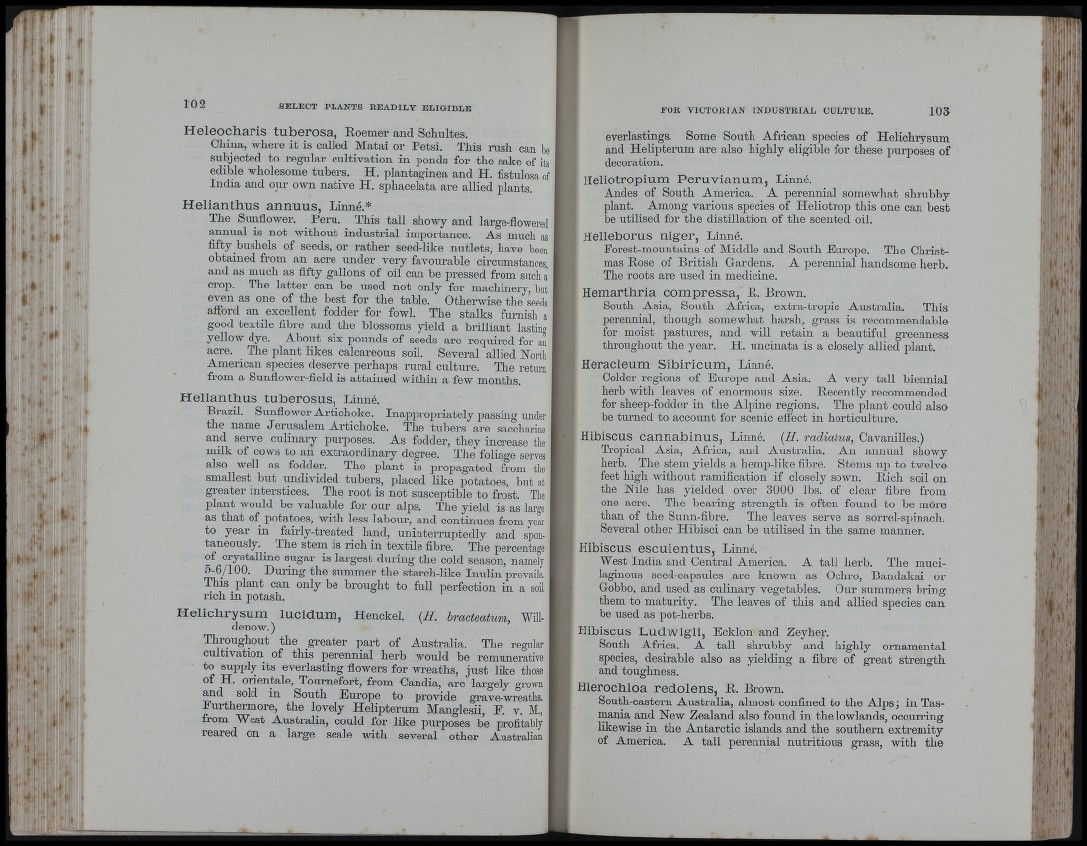
t
i K
. . M
I '
.Il il
102 SELECT PLANTS READILY ELIGIBLE
Heleocharis tuberosa, Eoemer and Schultes.
China, where it is called Matai or Petsi. This rush can be
subjected to regular cultivation in ponds for the sake of its
edible wholesome tubers. H. plantaginea and H. fistulosa of
India and our own native H. spbacelata are allied plants.
Heliantbus annuus, Linné.*
The Sunflower. Peru. This tall showy and large-flowered
annual is not without industrial importance. As much as
fifty bushels of seeds, or rather seed-like nutlets, have been
obtained from an acre under very favourable circumstances,
and as much as fifty gallons of oil can be pressed from such a
crop. The latter can be used not only for machinery, but
even as one of the best for the table. Otherwise the seeds
afibrd an excellent fodder for fowl. The stalks furnish a
good textile fibre and the blossoms yield a brilliant lasting
yellow dye. About six pounds of seeds are required for an
acre. ^ The plant likes calcareous soil. Several allied North
American species deserve perhaps rural culture. The return
from a Sunflower-field is attained within a few months.
Heliantbus tuberosas, Linné.
Brazil. Sunflower Artichoke. Inappropriately passing under
the name Jerusalem Artichoke. The tubers are saccharine
and serve culinary purposes. As fodder, they increase the
milk of cows to an extraordinary degree. The^ foliage serves
also well as fodder. The plant is propagated from the
smallest^ but imdivided tubers, placed like potatoes, but at
greater interstices. The root is not susceptible to frost. The
plant would be valuable for our alps. The yield is as large
as that of potatoes, with less labour, and continues from year
to year in fairly-treated land, uninterruptedly and spontaneously.
^ The stem is rich in textile fibre. The percentage
of crystalline sugar is largest during the cold season, namely
5-6/100. During the summer the starch-like Innlin prevails.
This ^ plant can only be brought to full perfection in a soil
rich in potash.
Helicbrysuui luciduui, Henckel. (AT. bracteatum, Willdenow.)
Throughout the greater part of Australia. The regular
cultivation of this perennial herb would be remunerative
to supply its everlasting flowers for wreaths, ju st like those
of H, orientale, Tournefort, from Candia, are largely grown
^ d sold in South Europe to provide grave-wreaths.
Furthermore, the lovely Helipterum Manglesii, F. v. M „
from West Australia, could for like purposes be profitably
reared on a large scale with several other Australian
FOR VICTORIAN INDUSTRIAL CULTURE. 103
everlastings. Some South African species of Helichrysiim
and Helipterum are also highly eligible for these purposes of
decoration.
Heliotropium Peruvianum, Linné.
Andes of South America. A perennial somewhat shrubby
plant. Among various species of Heliotrop this one can best
be utilised for tlie distillation of tbe scented oil.
Helleborus niger, Linné.
Forest-mountains of Middle and South Europe. The Christmas
Rose of British Gardens. A perennial handsome herb.
The roots are used in medicine.
Hemarthria compressa, P. Brown.
South Asia, South Africa, extra-tropic Australia. This
perennial, though somewhat harsh, grass is recommendable
for moist pastures, and will retain a beautiful greenness
throughout the year. H. uncinata is a closely allied plant.
Heracleum Sibiricum, Linné.
Colder regions of Europe and Asia. A very tall biennial
herb with leaves of enormous size. Recently recommended
for sheep-fodd(;r in tbe Alpine regions. Tbe plant could also
be turned to account for scenic efibct in horticulture.
Hibiscus cannabinus, Linné. (AT. radiatus, Cavanilles.)
Tropical Asia, Africa, and Australia. An annual showy
herb. The stem yields a hemp-like fibre. Stems up to twelve
feet high without ramification if closely sown. Pich soil on
the Nile has yielded over 3000 lbs. of clear fibre from
one acre. Tbe bearing strength is often found to be mòre
than of the Sunn-fibre. The leaves serve as sorrel-spinach.
Several other Hibisci can be utilised in the same manner.
Hibiscus esculentus, Linné.
West India and Central America. A tall herb. The mucilaginous
seed-capsules are known as Ochro, Bandakai or
Gobbo, and used as culinary vegetables. Our summers bring
them to maturity. The leaves of this and allied species can
be used as pot-berbs.
Hibiscus Ludwigii, Ecklon and Zeyber.
South Africa. A tall shrubby and highly ornamental
species, desirable also as yielding a fibre of great strength
and toughness.
Hierochloa redolens, P . Brown.
South-eastern Australia, almost confined to the Alps; in Tasmania
and New Zealand also found in the lowlands, occurring
likewise in the Antarctic islands and the southern extremity
of America. A tall perennial nutritious grass, with the
,'N ''
0
1* I
Iv:: 'I
Irli'':':.